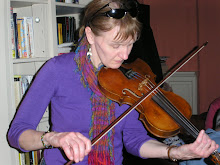
I'm back in Glasgow leading another group of fiber enthusiasts through this wonderful country. As we headed north out of the city for the first venue of the trip, Stirling Castle, the sun broke through the mist and bestowed a rosy glow to the rest of the day.
The site of many famous battles, it rises out of the lowlands as the entrance gate into the highlands. From the castle you gaze across fields where many battles have taken place in earlier history and look across to the Wallace monument. Many different buildings and fortifications have stood on this site since the 1200’s. Historic Scotland's website can fill in the details of this historic place. www.historic-scotland.gov.uk
We have the current renovation of King James V palace to thank for the Unicorn tapestry project. Historic Scotland is working with the West Dean Tapestry studio to recreate the 7 tapestries in the Hunt of the Unicorn series.The originals are in the Metropolitan's Cloisters Museum in New York City. Tracy Chevalier also wrote an excellent historical fiction book called “The Lady & the Unicorn.”
Since records show King James had many tapestries in his palace, very likely including a version of the Unicorn tapestries, the Hunt series was chosen to be made anew. Louise Martin, the head weaver of the project, gave us an in-depth look into the scope of this amazing project. The 3 tapestries already completed are hanging on display at the Chapel Royal. it was fabulous to see the "The Unicorn is killed and brought to the castle" being woven on last y
 ear's trip, completed and hanging in full glory. The image you see is this tapestry.
ear's trip, completed and hanging in full glory. The image you see is this tapestry.The weavers are currently working on "the unicorn at bay." A temporary studio was built on the north end of the castle for this project. 3 weavers work on the project. A 5th tapestry is being woven at the West Dean Tapestry studio in England. The entire project will be completed in 2012 when the whole set of tapestries will hang in the newly renovated palace at Stirling Castle. http://www.westdean.org.uk/tapestrystudio/commissions/historicscotland.shtml
To render the full scale design and cartoon, the head weavers go to New York to the Cloisters. They have access to within one millimeter of the original tapestries but cannot touch them. They figure out yarn colors and make a detailed plan for each figure and motif in each tapestry. Working from full size color copy, they make an acetate tracing of the tapestry. Then from this they make a paper cartoon. Samples are woven to work out specific techniques to achieve desired effects.The wool yarn is all dyed at the West Dean studio. Instead of silk, pearl cotton is being used for the shiny parts as it has longer color fastness. Historic Scotland requires that the materials being used in the tapestry hold up for 250 years.
Reweaving the tapestries is not a matter of copying. First, the new tapestries are being woven 10 % smaller than the originals to fit in the space in the palace. They are weaving with fewer EPI (ends per inch) in the warp) because it would take too long and cost too much money to weave them at the original finer warp set. (A patron in her eighties is financing the project.) Also, the head weavers have to train the weavers who come in to weave each tapestry. Although all experienced tapestry weavers, they need to undertand the specific techniques and develop nuances of skill. There will be about 25 weavers total who have worked on the series by the time it is completed. Each weaver has to leave their own individuality and style behind and try to get into the mind of the original weavers as they work. Getting this inside look at the current project
 was really special. The scope, historical accurateness, detail, and dedication is amazing.
was really special. The scope, historical accurateness, detail, and dedication is amazing.We went back to Glasgow for lunch at the House for an Art Lover Cafe before tour of the house. I personally can recommend the delicous salmon entree. The house was designed over 100 years ago by Charles Renne Mackintosh for a contest to design a house for an art lover. He submitted his entry under the pseudonym "Der Vogel" and indeed throughout the house, you find motifs of birds. He did not win the competition. But in 1980, two businessmen decided his house should be built. And in 1996, the house, in Bellahouston Park, opened.

The clean lines and the influence of nature inside the house was influenced by Mackintosh's appreciation of Japanese design. Throughout the home the "Mackintosh Rose" symbol appears again and again. Margaret, Charle's wife, a fine artist, designed the gesso plaques and the stipling on the wall . When the house was built, students from the Glasgow School of Art and other area artisans recreated the furniture, cabinets, stained glass, virtually the entire interior as the Mackintosh's designed it 100 years ago.
Charles died in 1928, poor and virtually f
 orgotten, and Margaret died in 1932. Their marriage was a true love story. Today, people world wide value the design aesthetic we today call "Mackintosh" There are many other sites in the Glasgow area that feature the architecture and interiors of Charles Mackintosh. The House for an Art Lover might be a good place to start. www.houseforanartlvoer.co.uk
orgotten, and Margaret died in 1932. Their marriage was a true love story. Today, people world wide value the design aesthetic we today call "Mackintosh" There are many other sites in the Glasgow area that feature the architecture and interiors of Charles Mackintosh. The House for an Art Lover might be a good place to start. www.houseforanartlvoer.co.uk

No comments:
Post a Comment